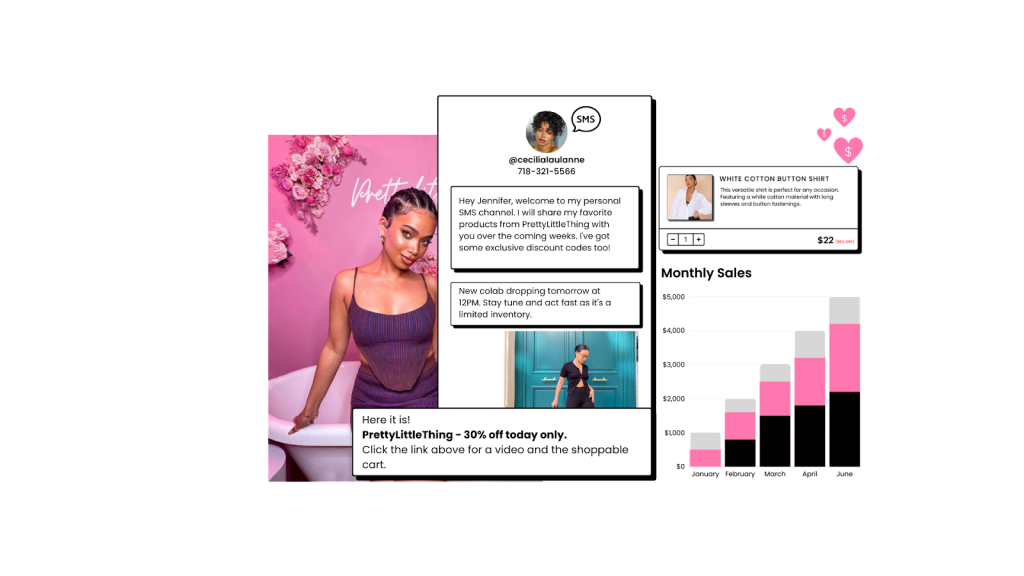Category: Social Commerce
Social commerce capabilities are showing up across many of the social media platforms we use everyday and some exciting new opportunities have come along with it.
If you haven’t already, it is time you learnt exactly what social commerce is, why your brand should be using it, and how to go about doing that.
What is social commerce?
Social commerce is the selling of goods directly on a social media platform, one form of social commerce you’ve most likely interacted with already is the ‘Shop’ tab on your Instagram app. This feature was revamped by Instagram in 2020 because they saw the need for retailers to boost sales and streamline the shopping process.
The easily accessible tab makes it easy for scrolling users to quickly turn into shoppers. Other platforms including Facebook and Pinterest also offer social commerce capabilities and TikTok, YouTube, and Twitter have begun experimenting with shop buttons so we expect to see more social commerce features from them popping up soon.
Here at Outfit we are working on our own form of social commerce that we are calling CreatorCart. This will utilize highly engaging SMS and allow your brand to sell across all channels via your curated influencer tribe. The results so far have incredible and we can’t wait to share more on this with you soon.
Why should my brand be using social commerce?
- Streamline the shopping experience
Online purchases tend to have a much higher cart abandonment rate. This is thought to be due to a number of factors including customers getting distracted on their way to purchase products and the smaller screen deterring people from buying, especially first time customers and bigger purchases. Social commerce attempts to combat these drop offs with a more streamlined, mobile-friendly experience. With less distractions and a more direct path to purchase there will be less opportunities for brands to lose customers during their online retail journey.
- Make shopping social
Social commerce makes shopping a more social and shareable experience. It makes it easy for users to share products they have discovered with friends privately in messages as well as publicly as links and posts on their social pages. This means there are even more opportunities for your products to be shared with potential new customers.
2. Millennials and Gen-Z’s love it!
The 18-34 demographic feel comfortable and familiar with these apps. They are already online and taking advantage of social commerce. Almost half of Gen-Zs and Millenials have made a purchase via social media and another 27% wanting to give it a try.

How do I get started?
- Getting set up
Instagram and Facebook both require you to set up your catalogs in Facebook Shop in order to start using these features. Once connected, partner platforms like Shopify will automatically sync up your store for you.
Pinterest also allows users to set up catalogs with Shopify but the process is more manual if your online store is on another platform. Pinterest does not offer purchasing in app right now so users will be redirected to your website.
Our own social commerce platform CreatorCart will plug directly into your Shopify store and there is no need to rely on any other social media channel in order to create customizable, sharable micro-sites for each influencer you are working with. This also means that you have complete control over all of the customer data and attribution.
Click here to apply for early access to CreatorCart.
2. Promote it with great content
Once you are set up it is time to start promoting this new way for your customers to shop. Create engaging content that drives users to your shop. Don’t forget to tag whatever products you are talking about in the content so people can immediately shop for those items. Influencer content will be the most engaging and it will also help you reach more people within your target audience. Outfit can help you with every step of the influencer marketing process so click here to get started planning your campaign today.
Influencer Marketing
You may have heard of the watch brand Daniel Wellington. In 2011, the founder of the Swedish brand, Filip Tysander, opted to forego conventional celebrity sponsorships. Instead, he came up with a unique marketing strategy to announce his new company.
He chose relevant Instagram influencers and gave them Daniel Wellington watches. He urged these influencers to use the hashtag #DanielWellington when they uploaded images of the watches on their Instagram accounts.
Every influencer was given a unique promo code that they could include alongside their posts to give their followers a discount, prompting them to buy Daniel Wellington watches.
Tysander now had access to a wealth of user-generated content that could be used as real-world testimonials. With the help of Instagram influencers, he was able to grow Daniel Wellington into a $220 million business.
Tysander’s use of Instagram was a masterstroke. Remember, this was 2011 – yet he chose a social media platform relevant to his target demographic – young and creative individuals.
Word spread fast. Tysander’s plan was working – it drew even more fans to the brand, and Tysander started seeing conversions. The company gained 1 million followers in its first year and today has 4.8 million followers on Instagram. Over the past decade, millions of companies worldwide have followed Tysander’s example.
Why influencer marketing is taking center stage
Last year, Apple’s iOS 14.5 update required users to share their unique Identifier for Advertisers (IDFA) – an identification number issued to each iOS user – to allow advertisers to provide personalized ads in apps.
Before the update, around 70% of iPhone users shared their IDFA with advertisers through apps, which allowed advertisers to track users and their preferences. However, today only 13% of users worldwide and 5% of users in the US share their IDFA.
Besides, the cost per thousand impressions (CPM) on Facebook and Google has become more expensive, and advertisers are emptying their pockets while fighting a losing battle to reach the consumer. For this reason, advertisers are moving to influencer marketing over traditional advertising methods.
Influencers tend to forge closer relationships with their followers, leading to higher conversion rates for brands that market through them. The success of influencer marketing will lead brands to spend a whopping $16.4 billion in 2022 on influencer marketing.
Source: influencermarketinghub.com
The rise in video marketing and social commerce
Video marketing has grown rapidly in recent years – with 92% of marketers considering video an important part of their marketing strategy.
Videos have been found to get more engagement than photos on social media, depending on your audience. While a mix of both is considered the best route to follow, marketers see photos as content that can be consumed in a few seconds before the viewer moves on.
On the other hand, videos urge viewers to pause and pay attention to the information, resulting in more clicks and conversions. As a result, video advertising on mobile has greater click-through rates.
The rising popularity of short video formats like Instagram Reels, TikTok, and YouTube Shorts and the impact of the global pandemic on consumers, which boosted social media consumption, has contributed to the growing trend of video marketing.
(Image credit: The Verge)
Another thriving industry is social commerce, which is the process of selling products directly on social media. Social commerce is no longer limited to advertising.
Users can now make purchases without leaving an app, making the buying process easier. The complete shopping experience – from discovering a product to paying for it – takes place directly on a social media platform.
Various social media platforms are increasingly offering companies new channels to drive sales. For example, many brands sell products directly on social media platforms like Instagram, Facebook, and Pinterest through influencer marketing.
40% of users say that they buy products online after seeing an influencer they follow promote them, while 88% of users say it’s important for the influencers they follow to be authentic and have a genuine interest in the products and services they promote online.
According to a study by PR Newswire, worldwide social commerce sales totaled $89.4 billion in 2020 but are predicted to multiply sixfold by 2027, reaching $604.5 billion in total value.
The importance of micro-influencers
Influencer marketing is now considered a key advertising approach, with 93% of companies using influencer marketing as part of their campaigns.
Many companies – especially smaller businesses – tend to choose micro-influencers over macro-influencers for their marketing campaigns. Despite having fewer followers than macro-influencers, their followers are more engaged and willing to take action. This is because they possess the characteristics that today’s consumers prize: honesty, relatability, and credibility.
As companies become increasingly cautious about fake influencers, a number of marketing teams have started planning and executing campaigns in-house. This helps safeguard the brand image and guarantees campaign effectiveness.
Find authentic influencers you can trust
Going through thousands of influencers, identifying the right ones, reaching out to them, and coordinating with them for a single Instagram post can be tedious.
There are up to 38 million influencers on social media. Even if you find the right one for your brand, measuring that influencer’s impact on your sales is almost impossible – not to mention the number of fake influencers and bot accounts out there.
Outfit is an end-to-end influencer marketing platform enabling marketing teams to identify influencers who are likely to drive the highest conversion and communicate with large numbers of micro-influencers easily. We let you manage your marketing campaign, payments and report on the great results all in one place.

